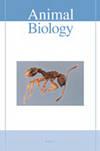热带河口模式眼周不同早期生活阶段的时空发生
IF 0.9
4区 生物学
Q2 ZOOLOGY
引用次数: 2
摘要
为了阐明两栖鱼类莫氏Periophthalmus modestus在其最南端栖息地的分布模式,在两年多的时间里,每月在红河三角洲地区的不同地点进行一次调查。从空间上看,在Ba Lat河口沿线的采样点和靠近河流主要支流的附近红树林中的一个采样点,浮游幼虫被大量捕获。底栖和两栖幼体主要在红树林中捕获。这一发现表明,P.modestus幼虫可能被潮流从产卵场向上输送,并可能在浮游幼虫阶段将Ba Lat河口的主要支流用作苗圃栖息地,并在定居阶段将其栖息地扩展到河口沿岸的红树林。从时间上看,浮游幼虫出现在2月至7月,并在5月达到高峰,这表明本鱼在越南的主要繁殖季节是2月至七月,比温带地区更早。随着时间的推移,该物种幼虫和幼体的丰度与水温呈正相关。基于大小类组合、采样月数和采样点的非度量多维定标(NMDS)模型,以及环境矢量的叠加,表明水温与鱼类大小显著相关。体型较小的鱼类往往出现在较低的温度下,而体型较大的鱼类则往往出现在较高的温度下。本研究揭示的该物种的分布模式可能在一定程度上有助于其成功适应该热带地区的环境。本文章由计算机程序翻译,如有差异,请以英文原文为准。
Spatio-temporal occurrence of different early life stages of Periophthalmus modestus in a tropical estuary
To elucidate the distribution pattern of Periophthalmus modestus, an amphibious fish, at its southernmost habitat, an investigation was conducted monthly at different locations along the Red River Delta area over two years. Spatially, planktonic larvae were caught abundantly at sampling sites along the Ba Lat Estuary and at a single site in the nearby mangroves close to the river’s main tributary. The benthic and amphibious juveniles were caught mainly in the mangroves. This finding suggests that P. modestus larvae may be transported up the river from the spawning ground by the tidal current and may use the main tributary of Ba Lat Estuary as a nursery habitat for the planktonic larval stage and expand their habitat to the mangrove along the estuary during the settling stages. Temporally, planktonic larvae occurred from February to July and peaked in May, suggesting that the main reproductive season of this fish in Vietnam is from February to July, which is earlier than in temperate areas. The abundance of larvae and juveniles of this species over time was positively correlated with water temperature. Nonmetric multidimensional scaling (NMDS) models based on size-class assemblages, months of sampling and samplings sites, together with an overlay of environmental vectors, revealed that water temperature was significantly correlated with fish size. Fish in the smaller size class tended to occur at lower temperatures, and fish in the larger size class tended to occur at higher temperatures. The distribution pattern of this species revealed in this study may partly contribute to its successful adaptation to circumstances in this tropical area.
求助全文
通过发布文献求助,成功后即可免费获取论文全文。
去求助
来源期刊

Animal Biology
生物-动物学
CiteScore
2.10
自引率
0.00%
发文量
34
审稿时长
3 months
期刊介绍:
Animal Biology publishes high quality papers and focuses on integration of the various disciplines within the broad field of zoology. These disciplines include behaviour, developmental biology, ecology, endocrinology, evolutionary biology, genomics, morphology, neurobiology, physiology, systematics and theoretical biology. Purely descriptive papers will not be considered for publication.
Animal Biology is the official journal of the Royal Dutch Zoological Society since its foundation in 1872. The journal was initially called Archives Néerlandaises de Zoologie, which was changed in 1952 to Netherlands Journal of Zoology, the current name was established in 2003.
 求助内容:
求助内容: 应助结果提醒方式:
应助结果提醒方式:


